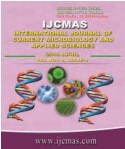


 National Academy of Agricultural Sciences (NAAS)
National Academy of Agricultural Sciences (NAAS)

|
PRINT ISSN : 2319-7692
Online ISSN : 2319-7706 Issues : 12 per year Publisher : Excellent Publishers Email : editorijcmas@gmail.com / submit@ijcmas.com Editor-in-chief: Dr.M.Prakash Index Copernicus ICV 2018: 95.39 NAAS RATING 2020: 5.38 |
Weed problems are very complex and serious in coffee plantations of North East Region of India because of favourable agro climatic situations for weed growth. The study on emergence and population dynamics of weeds will help to develop efficient weed management strategy. Therefore, the present investigation was undertaken for two consecutive years in 2016 and 2017 at the Experimental Garden for Plantation Crops of Assam Agricultural University, Jorhat, Assam with the objective to study the weed dynamics in rejuvenated robusa coffee. In soil seed bank study, the weed emergence was recorded in decreasing order of Borreria articularis, Sporobolus sp, Ageratum hostonianu, Isachne globosa, Mikania micrantha, Polygonum sp, Diplezium esculentum and Digitaria setigera. The weeds present in rejuvenated coffee consisted of two species of grasses, one species of sedge and six species of broad leaf weeds. Among the grassy weeds, Isachne globosa and Sporobolus sp. were the dominant ones. The only sedge present was Cyperus iria. The predominant among broad leaf weeds were Mikania micrantha, Gynura bicolor, Spermacoce hispida and Scoparia dulcis. The weed dynamics revealed the peak density of grass, sedge and broad leaf weed at 80, 120 and 80-160 days after manual weeding and thereafter showed a decreasing trend.
 |
 |
 |
 |
 |